![]()
Hamster Coin: A Comprehensive Guide to the Meme Cryptocurrency
The cryptocurrency market is home to a vast array of projects, ranging from utility-focused tokens to meme coins driven by online communities. Among these, Hamster Coin (HAM) has captured attention as a meme-based cryptocurrency that plays on the success of earlier projects like Dogecoin and Shiba Inu. Launched with a focus on fun and community, Hamster Coin has quickly garnered a following, fueled by the global craze for meme coins.
In this article, we will explore the origins, technology, potential future, and broader market context of Hamster Coin. We’ll also discuss whether Hamster Coin holds any real utility or if it’s simply another speculative asset in the rapidly expanding world of decentralized finance (DeFi).
What Is Hamster Coin?
Hamster Coin (HAM) is a meme cryptocurrency that was launched in 2021. Like Dogecoin and Shiba Inu, it is driven largely by community enthusiasm rather than any specific technological innovation or real-world use case. The project’s developers aimed to create a fun and accessible token, with an emphasis on decentralization, community participation, and humor.
The coin gained quick attention, particularly on social media platforms like Twitter and Reddit, where it was shared and promoted by meme coin enthusiasts. Although its technical infrastructure is relatively simple, the novelty and community-centered nature of Hamster Coin have contributed to its viral popularity.
The Rise of Meme Coins and Hamster Coin’s Place in the Market
The success of Dogecoin (DOGE), which started as a joke and eventually became one of the top cryptocurrencies by market capitalization, has paved the way for meme coins like Hamster Coin. These coins often have minimal utility and are primarily valued for their entertainment factor and speculative potential.
With Dogecoin’s explosive growth in 2020 and 2021, fueled by celebrity endorsements and online communities, many investors started searching for the next meme coin to achieve similar success. This led to the rise of coins like Shiba Inu (SHIB) and Hamster Coin (HAM), as traders began treating them as potential “get-rich-quick” opportunities. However, as with all meme coins, it’s crucial to approach Hamster Coin with caution due to its volatile nature and lack of fundamental backing.
How Does Hamster Coin Work?
Hamster Coin operates on the Binance Smart Chain (BSC), a blockchain platform known for its low transaction fees and high throughput. As a BEP-20 token, HAM is relatively easy to trade and integrate into decentralized applications on the Binance Smart Chain.
Because Hamster Coin is a meme coin, it doesn’t have any inherent technological innovation or distinct advantage over other cryptocurrencies. The primary driver behind the coin is its community and the speculative interest surrounding meme coins. That said, its use of Binance Smart Chain ensures that transactions are fast and affordable compared to Ethereum-based tokens, which is a small technical benefit for users.
Key Features of Hamster Coin:
- BEP-20 Token Standard: HAM is built on Binance Smart Chain, making it compatible with BSC wallets and applications.
- Decentralization: Like many cryptocurrencies, Hamster Coin aims to decentralize control, meaning that it doesn’t have any central authority dictating its future.
- Community-Driven: The project’s value and visibility are largely fueled by its online community and viral marketing strategies.
Tokenomics and Distribution
A key factor for any cryptocurrency, especially meme coins, is its tokenomics—the economics governing the creation, distribution, and supply of tokens. Hamster Coin initially launched with a total supply of 10 quadrillion tokens, an incredibly high number compared to other cryptocurrencies like Bitcoin, which has a capped supply of 21 million coins.
Such a large supply means that each individual HAM token is worth very little in terms of fiat currency, often less than a fraction of a cent. However, the large supply also creates room for significant price appreciation should demand rise.
Additionally, Hamster Coin’s creators have implemented a token burn mechanism, which gradually reduces the total supply of HAM over time. Token burns are typically used to create scarcity, with the aim of driving up the price as supply decreases.
Trading and Liquidity
Hamster Coin can be traded on various decentralized exchanges (DEXs) like PancakeSwap, a popular platform on Binance Smart Chain. Its liquidity is primarily driven by community participation, and early investors can often benefit from the high volatility that meme coins experience. However, this also introduces risk, as liquidity can dry up quickly if interest in the coin wanes.
Due to its high risk and speculative nature, Hamster Coin is mainly traded by short-term traders and those looking to capitalize on potential price spikes. The coin’s liquidity pools on PancakeSwap are the primary source of trading volume, and the coin may experience sudden price surges due to viral marketing efforts or endorsements from influencers.
The Role of Social Media in Hamster Coin’s Success
Hamster Coin, like most meme coins, relies heavily on social media platforms to drive its visibility and attract investors. Twitter, Reddit, and Telegram groups have played a significant role in promoting the coin and creating a sense of community among its holders. These communities often use humor, memes, and viral challenges to bring attention to the coin, similar to how Dogecoin’s community operates.
While this grassroots marketing has proven effective in driving short-term interest and speculative buying, it also means that the coin’s value is highly dependent on continued social media engagement. A decline in viral marketing efforts or social media chatter could result in a rapid drop in the coin’s price.
Risks Associated with Investing in Hamster Coin
Like all cryptocurrencies, Hamster Coin carries inherent risks, particularly because it falls under the category of meme coins, which are known for their volatility. Investors should be aware of the following risks:
- High Volatility: Meme coins, including Hamster Coin, experience extreme price fluctuations. While there is potential for short-term gains, the value can drop just as quickly, resulting in significant losses.
- Lack of Utility: Unlike projects like Ethereum or Polkadot, which have clear technological use cases and ecosystems, Hamster Coin has little to no real-world utility beyond its role as a speculative asset. This makes it more prone to price bubbles and crashes.
- Dependence on Community Engagement: Hamster Coin’s success is tied to its social media presence and viral appeal. If the community loses interest or moves on to other projects, the coin’s value could plummet.
- Regulatory Risks: As with all cryptocurrencies, there is the potential for increased regulatory scrutiny, particularly regarding meme coins and speculative investments. Governments and financial regulators may impose restrictions that could affect the coin’s liquidity and accessibility.
- Market Competition: Hamster Coin is one of many meme coins in a crowded market. Competing with more established coins like Dogecoin and Shiba Inu makes it difficult to stand out, especially if larger meme coins dominate public attention.
Future Prospects: Can Hamster Coin Survive?
The long-term survival of Hamster Coin depends on its ability to maintain community interest and evolve in a way that adds value beyond being a meme token. Some potential avenues for growth include:
- Expanding the Ecosystem: If Hamster Coin’s developers can build decentralized applications or platforms that utilize the HAM token, it could provide a more sustainable use case and attract a broader audience.
- Collaborations and Partnerships: Forming partnerships with other blockchain projects or platforms could increase the coin’s visibility and utility.
- Continued Viral Marketing: As with most meme coins, staying relevant and engaging through social media is critical to maintaining price momentum and growing the community.
Conclusion: Is Hamster Coin Worth the Investment?
Hamster Coin represents the unpredictable and speculative nature of meme coins in the cryptocurrency market. Its viral rise, fueled by social media engagement and the broader meme coin phenomenon, makes it an exciting but high-risk investment. While some traders have seen substantial gains from meme coins like Hamster Coin, investors must be aware of the inherent risks, including volatility, lack of utility, and market competition.
For those who enjoy the excitement of meme coin trading and are willing to embrace the high risks, Hamster Coin could be a fun and potentially rewarding short-term investment. However, for long-term investors, it’s essential to approach Hamster Coin and other meme coins with caution, as their value is often driven more by community hype than by technological or fundamental backing.
In the ever-evolving world of cryptocurrency, Hamster Coin serves as a reminder that, while opportunities for quick gains exist, they are often accompanied by significant risks. Always do thorough research and consi



